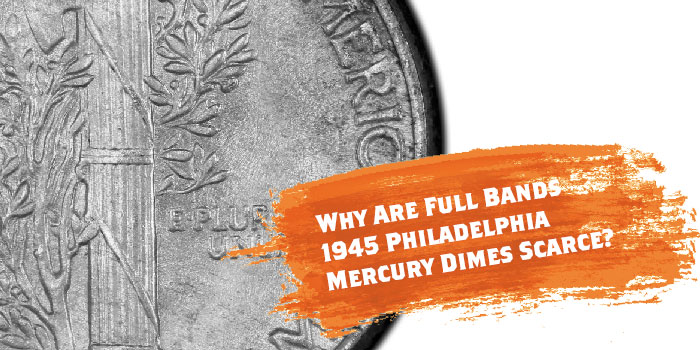
By Joshua McMorrow-Hernandez for PCGS ……
Mercury dime specialists and anybody else who loves nicely struck examples of these mid-20th-century silver coins knows that examples with Full Bands (FB) details are among the most desirable. But certain issues are scarcer with fully struck horizontal bands across the fasces than others.
And among the scarcest of all when it comes to those with the coveted FB designation are the 1945 Philadelphia Mint issues, struck during the last year of production for this popular series designed by Adolph Weinman.
Collectors often come up short when on the pursuit of nicely struck 1945 Mercury dimes. PCGS estimates only 400 exist across all grades, and merely 100 in grades of MS65 or better. In the context of Mercury dimes, a series with mintages mostly in the tens of millions and survivorship numbers for late-date issues in the many tens of thousands, three-figure population estimates make for downright rare coins.
But why would the 1945 Mercury dime – a coin with a mintage of 159,130,000 pieces – be so scarce with Full Bands? It’s a question that has confounded coin dealers and coin collectors alike for decades.
By the mid-1970s, FB Mercury dimes were gaining steam in the collector market as a premium-quality coin, forcing pressure on the relatively limited supply of available FB Mercury dimes. This, of course, pushed prices up across the board for such nicely struck specimens. But even as more and more numismatists were finding and identifying FB Mercury dimes, the pool of 1945 Philadelphia issues with these same sharply struck details remained quite small.
Of course, one may posit that, as the Philadelphia Mint struck many more dimes than the other two mints in 1945 – Denver making about 40.2 million dimes and San Francisco approximately 41.9 million – the dies may have been worn out from overuse. Why then, aren’t there more FB dimes among the 1945 Philadelphia specimens? Even if the Philly dies were used for a much longer duration than those at Denver and San Francisco, logic would suggest that there would still be a sizable number of early strikes with sharp details and subsequently boasting full horizontal lines on the fasces.
In his 2005 book The Complete Guide to Mercury Dimes, coin expert David Lange theorizes that as all the dies for 1945 Mercury dimes were made at the Philadelphia Mint before being shipped to the Denver and San Francisco Mints, a roughly equal number of dimes from all three mints should exhibit Full Bands dimes. That is, of course, if the matter came down to die quality itself.
“Even if some of the reverse dies lacked center bands altogether, due to inadequate hubbing, their distribution would have been random among the three mints,” he writes.
It should be added here that PCGS estimates the number of 1945-D Mercury dimes with FB details to number 12,000 and the population of 1945-S FB specimens to be 5,000, with the population of MS65FB or better pieces to be 8,000 and 3,000, respectively.
Lange goes on to explain that the differences coming into play between the Philly Mint and the branch mints are the collars, made onsite at each of the mints, and the upsetting mill, that of each mint possibly imparting slight differences in the size, thickness, and shaping of the rims on the newly made planchets.
“Slight differences in the diameter of the collar of the curvature of the rims could result in detectable variations in the finished coins,” he notes. “An excellent example of this influence is found in the 1921 (P) dimes, which almost invariably have Full Bands, yet typically are weak at their peripheries.
At any rate, 1945 Philadelphia Mercury dimes with FB designation are decidedly difficult to locate. MS63FB and 64FB specimens trade for around $6,000 and $9,000, respectively. PCGS has graded only 38 in a grade of MS65FB, with realized auction prices recently trending around $15,500.
In MS66FB, just 18 pieces exist in PCGS holders and have market values closer to $18,000. As for MS67FB examples, only PCGS examples exist, with scant sales data for these pieces reflecting prices of around $47,500.
The highest-known PCGS examples grade MS67+FB, with just two such known and one commanding a respectable $90,000 in a June 2019 auction.
* * *






Photos of examples would have been very helpful.